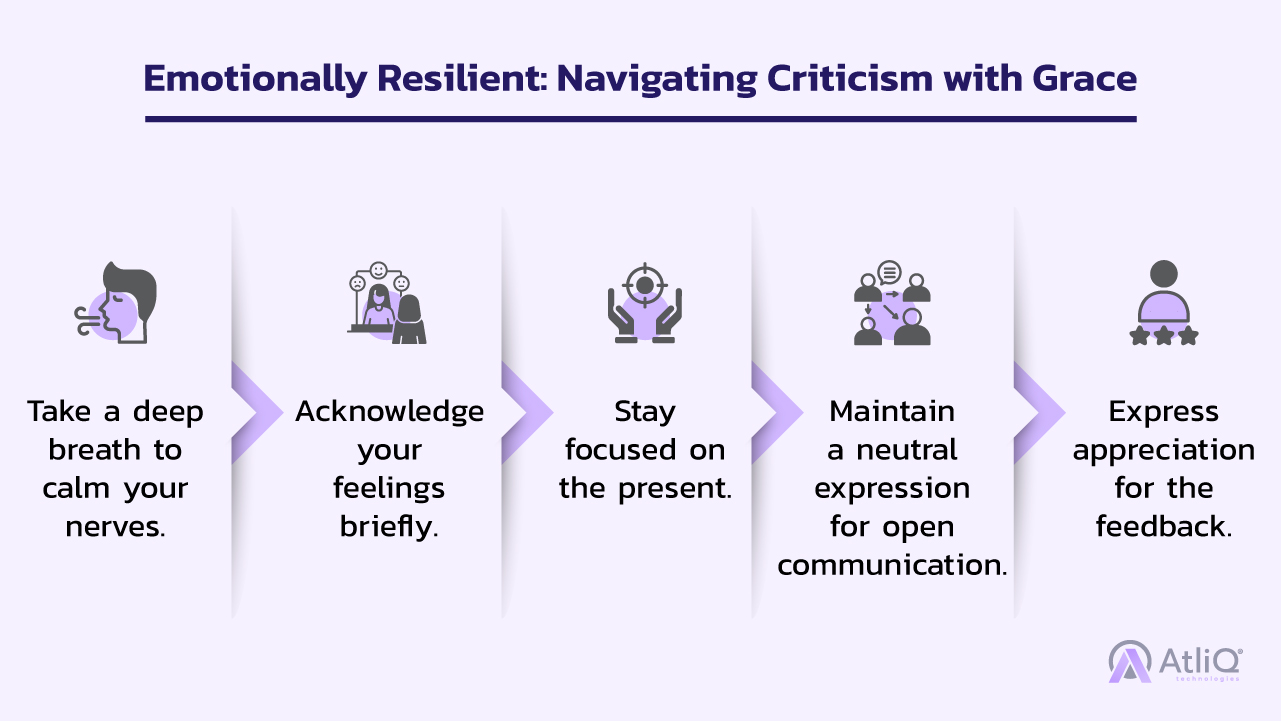
Imagine this: you’ve poured your heart and soul into a project, only to receive feedback that feels like a punch to the gut. Criticism can be a double-edged sword, leaving us feeling demoralized or empowered, depending on how we approach it. But what if the choice lies entirely in your hands?
This blog is your guide to unlocking the potential of criticism and turning it into a catalyst for growth. We’ll explore how to shift your perspective, navigate the emotional rollercoaster, and extract valuable insights from even the most challenging feedback.
Get ready to transform criticism from a roadblock to a launchpad for your success.
Let’s be honest, criticism rarely feels like a warm hug. It can sting, bringing up feelings of inadequacy, frustration, and even anger. This discomfort is a natural human response. Our brains are wired to seek out approval and avoid rejection, so receiving criticism can feel like a threat to our self-worth. It’s important to acknowledge that discomfort is normal. However, letting it completely shut down our ability to process the feedback hinders our ability to learn and grow. The key lies in acknowledging the discomfort while simultaneously recognizing the potential positive impact of constructive criticism.
Shifting Your Mindset: From Fixed to Growth
Before we delve into receiving and analyzing criticism, it’s crucial to shift our underlying mindset from fixed to growth.
- Fixed vs. Growth Mindset:
Imagine two individuals, Sarah and Alex, both receive criticism on a presentation.
Sarah, with a fixed mindset, believes her intelligence and abilities are fixed. She might think, “I’m not a good presenter,” and feel discouraged from trying again.
Alex, with a growth mindset, sees her abilities as malleable and developed through effort. She might think, “This feedback highlights areas I can improve on,” and become motivated to practice and refine her skills.
The key difference lies in their perception of challenges and their growth potential. A fixed mindset views obstacles as permanent limitations, while a growth mindset sees them as opportunities to learn and evolve.
Why is a growth mindset important? When you embrace a growth mindset, you’re more likely to:
-
- View criticism as a learning opportunity rather than a personal attack.
- Embrace challenges and persist in the face of setbacks.
- Celebrate the effort and process of learning, not just the outcome.
- Recognizing the Purpose:
Often, criticism can feel personal, prompting us to focus solely on the words and forgetting the intent behind them. It’s helpful to consider the potential reasons someone might offer criticism:
-
- They genuinely want to help you improve. It is often the case with mentors, teachers, or colleagues.
- They have a different perspective and offer an alternate view. It can be beneficial for seeing the bigger picture or identifying blind spots.
- They are passionate about the project and want to ensure its success. This criticism, though harsh, can be aimed at maximizing the project’s potential.
Remember, understanding the intent behind the feedback can help you approach it with more openness and objectivity. By focusing on the potential for learning rather than taking everything personally, you’ll be better equipped to extract valuable insights from the criticism.
Receiving Criticism Effectively: Mastering the Art of Listening and Staying Calm
So, you’ve shifted your mindset and are ready to approach criticism as a potential growth opportunity. But how do you receive the feedback effectively and ensure you’re truly learning from it? Here’s how:
A. Practice Active Listening: Truly listening goes beyond simply hearing the words. It’s about actively engaging with the message and demonstrating genuine interest in understanding the feedback.
-
- Give your full attention: Put away distractions, like your phone, and avoid multitasking.
- Maintain eye contact: This shows that you’re present and engaged in the conversation.
- Nod and use nonverbal cues: Acknowledging the speaker through nonverbal cues shows you’re following along.
- Ask clarifying questions: If something is unclear, don’t hesitate to ask for clarification. This ensures you don’t misinterpret the feedback.
- Summarize what you’ve heard: Briefly paraphrase the key points of the feedback to demonstrate your understanding.
By actively listening, you demonstrate respect and encourage the other person to elaborate further, ultimately gaining a clearer understanding of their perspective and the feedback itself.
B. Manage Your Emotions: Let’s face it, criticism can trigger a range of emotions, from mild annoyance to full-blown anger. It’s important to acknowledge that these emotional responses are normal. However, letting your emotions control the situation can cloud your judgment and hinder your ability to process the feedback constructively.
Analyzing and Applying the Feedback: Turning Words into Action
Now that you’ve received the feedback and navigated the initial emotional response, it’s time to analyze and apply the insights. Remember, not all criticism is created equal, so it’s crucial to approach it with a critical and thoughtful perspective.
A. Evaluate the Validity: While the intent behind the feedback might be good, it’s still important to evaluate its validity objectively.
-
- Consider the source: Is the person offering the feedback qualified to provide expert advice on the topic?
- Look for evidence: Does the feedback come with specific examples or data to support the claims?
- Compare with other perspectives: Have others provided similar feedback?
It’s important to question and analyze the feedback without feeling obligated to accept everything at face value. If something seems unclear or ambiguous, don’t hesitate to seek clarification.
B. Identify Actionable Insights: The true value of criticism lies in its actionable insights. To ensure you’re not just listening passively, actively seek specific and actionable advice within the feedback.
-
- Look for concrete suggestions: Did the feedback offer specific recommendations for improvement?
- Identify areas for growth: Based on the feedback, are there specific areas you can work on developing?
- Break down the feedback into smaller steps: Can you create a plan of action with actionable steps to address the areas identified for improvement?
Putting it into Action: Transforming Feedback into Progress
You’ve received the feedback, analyzed its insights, and identified areas for improvement. Now it’s time to take action and turn those insights into tangible progress.
A. Develop a Plan: Simply acknowledging the feedback won’t be enough. To truly benefit from it, you need a concrete plan to address the identified areas for improvement.
-
- Set SMART goals: Define Specific, Measurable, Achievable, Relevant, and Time-bound goals based on the feedback. This will provide a clear roadmap for your progress.
- Outline actionable steps: Break down the goals into smaller, manageable steps. This will make the process feel less overwhelming and more achievable.
- Set realistic timelines: Be honest with yourself about the time and effort required to achieve your goals. Setting unrealistic deadlines will only lead to frustration.
- Track your progress: Regularly monitor your progress towards your goals. This will help you stay motivated and adjust your plan as needed.
B. Seek Support: Remember, you don’t have to navigate this journey alone. Seek out additional guidance or support from individuals who can help you along the way.
-
- Mentors: Find someone with experience in your field who can offer valuable advice and encouragement.
- Teachers or Coaches: Consider seeking professional guidance from someone equipped to provide specific training or support.
- Friends or Colleagues: Surround yourself with positive and supportive individuals who believe in you and can offer constructive feedback.
Don’t be afraid to ask for help when needed. Often, a fresh perspective or additional resources can make a significant difference in your journey towards improvement.
By developing a plan and seeking support, you increase your chances of successfully transforming criticism into positive action and progress. Remember, growth is a journey, not a destination, so embrace the process of learning and continuous improvement.
Criticism, while often uncomfortable, can be a powerful catalyst for growth and success. By shifting your mindset, actively receiving feedback, and applying actionable insights, you can transform criticism from a roadblock into a launchpad for your journey of self-improvement. Remember, the key lies in embracing the learning opportunity presented by criticism and utilizing it to fuel your growth. Don’t shy away from challenges, but instead, see them as opportunities to learn, adapt, and become the best version of yourself.
So, the next time you receive criticism, take a deep breath, approach it with an open mind, and remember: growth is rarely comfortable, but it’s always rewarding.
